AUDI A8 2013 Owners Manual
Manufacturer: AUDI, Model Year: 2013, Model line: A8, Model: AUDI A8 2013Pages: 318, PDF Size: 79.34 MB
Page 131 of 318
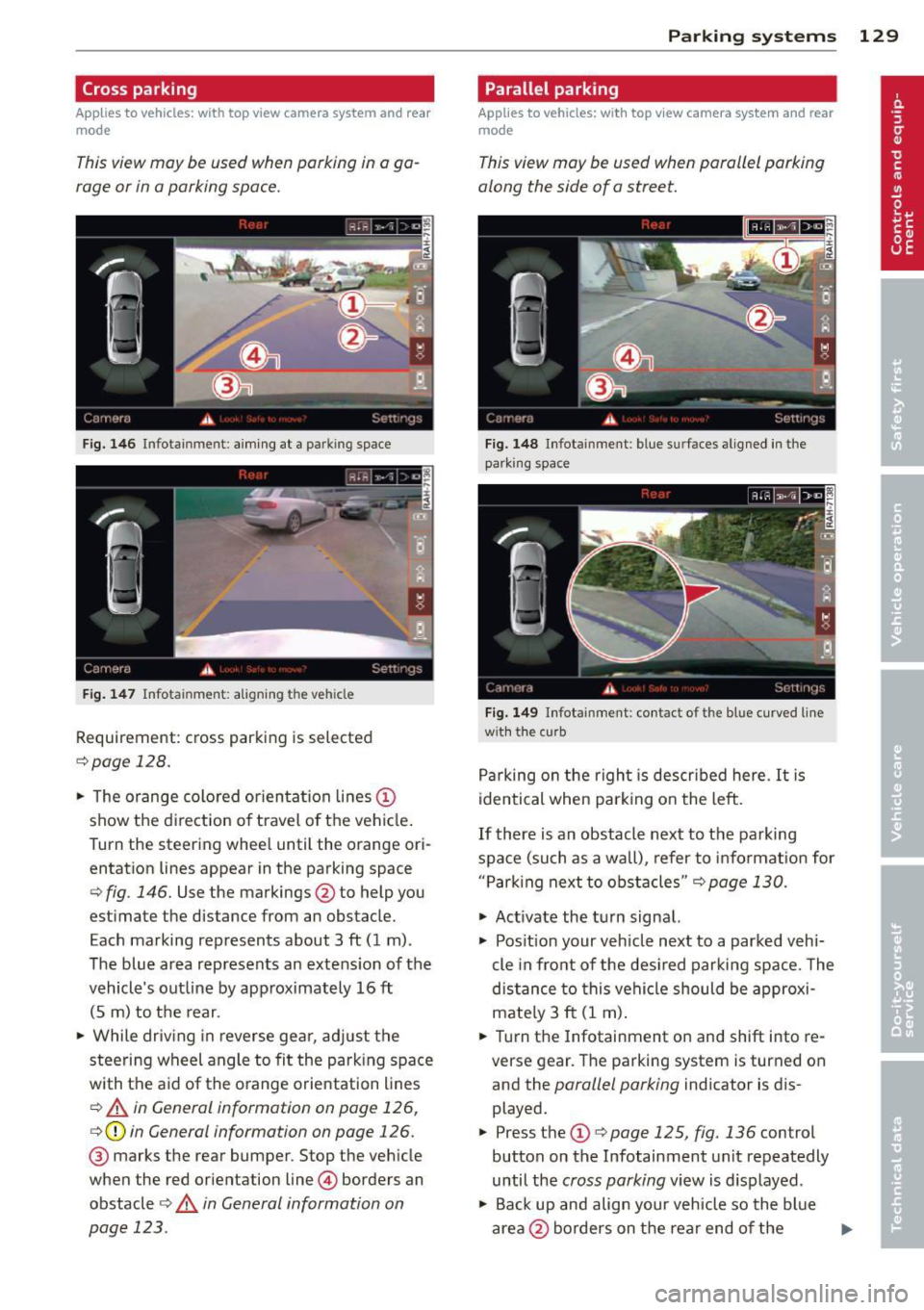
Cross parking
Applies to vehicles: with top view camera system and rear
mode
This view may be used when parking in a ga
rage or in a parking space.
Fig. 1 46 Infotainment: aiming at a parking space
Fig . 14 7 Infota inment: aligni ng the veh icle
Requirement: cross parking is selected
<=:> page 128.
.,. The orange colo red orien ta tion lines (D
show the d irection of t ravel of the vehicle .
Turn the steer ing whee l until the orange ori
entation lines appear in the parking space
¢ fig. 146. Use the markings @to help you
estimate the distance from an obstacle.
Each marking represents about 3 ft (1 m).
The blue area represents an extens ion of the
vehicle's out line by approximately 16 ft
(5 m) to t he rear .
.. While dr iv ing in reverse gear, adj ust the
steering wheel angle to fit the park ing s pace
with the aid of the o range orientation lines
¢ A in General information on page 126,
¢(D in General information on page 126.
@ marks the rear bumper. Stop the veh icle
when the red orientation line@) borders an
obstacle
¢ .& in General information on
page 123.
P arking systems 129
Parallel parking
Applies to vehicles: with top view camera system and rear
mode
This view may be used when parallel parking
along the side of a street.
Fig. 148 Infota inment : blue surfa ces aligned in the
park ing space
Fig. 149 Infotainment : co ntac t of the blue cu rved line
w it h the curb
P a rking on the r igh t is descr ibed here. It is
identical when park ing on the left.
If there is an obstacle next to the parking
spa ce (such as a wall), refer to info rmat ion for
" P ar king next to obst acles "
<=:>page 130.
.. Act ivate the turn signal.
.,. Pos it ion your veh icle next to a park ed veh i
cle in fro nt of the des ired parking space. The
distance to this vehicle should be approxi
mate ly 3 ft (1 m) .
.. Turn the Infotainment on and shift into re
verse gear . T he parking system is turned on
and the
parallel parking indicator is dis
played.
.. Press the
(D ¢ page 125, fig . 136 control
button on the Infotainment unit repeatedly
until the
cross parking v iew is d isplayed .
.,. Back up and align your vehicle so the blue
area @ borders on t he rear end of the
Iii>
Page 132 of 318

130 Park in g s ystems
vehicle or on the parking space line ¢ A in
General information on page 126, ¢(Din
General information on page 126 .
The blue
area represents an extension of the vehicle's
outline by approximately 16 ft (5 m) to the
rear . The long side of the blue area should
be o n the curb. The e ntire blue area must fit
into the parking space.
,. With the veh icle stopped, turn the steer ing
wheel to the right as far as it w ill go .
.. Back into the par king space until the b lue
curve
¢ page 125, fig . 137touches the curb
¢ A in General information on page 126,
q(D in General information on page 126.
Stop the vehicle.
,. With the vehicle stopped, turn the steering
wheel to the left as far as it will go .
,. Continue to back into the parking space un
t il the vehicle is pa rked pa ralle l to the curb
9 A in General information on page 126,
q(j) in General information on page 126.
@ marks the rear bumper. Stop the ve hicle,
at the latest, when the red orientation line
@ borders an object. Keep an eye on the
front of your vehicle wh ile doing this.
P arking ne xt to obstacles
When there is an obs tacle (such as a wall)
next to the parking space, choose a space with
more space on the sides. Position the long
side of the blue area so that there is sufficient
space from the curb. The area must not be on
the curb. You will also need to start turning
the steering wheel much earlier . There should
be a suffic ient amount of space between the
curb and the b lue curve, and the blue curve
¢ page 125, fig. 137 must not touch the cu rb.
(D Tips
The left or r ight orientation lin es and sur
faces will be displayed, depend ing on the
turn signa l being used.
Trailer view
Applies to vehicles: with top view came ra system and
tra iler hitch
This view assists you in positioning the vehicle
in front of a trailer.
Fig . 1 50 Infotainme nt: rear mode
Requirement: the trailer mode is selected
¢ page 128.
.. Now you can posit ion your veh icle in front
of the trai ler
c> A in General information
on page 126, ¢(Din General information
on page 126.
The orange co lored orienta
tion line denotes the expected path toward
the t railer hitch . Use the b lue lines to help
you estima te the distance to the tra iler
h itch .
Setting the mode
Applies to vehicles: with top view camera system
,. Select: I CAR I func tion button > C ar sy stem s
contro l butto n > Driver a ssist > Parking aid
> Change to front /rear > Auto or Manual.
Auto -
This v iew behind the veh icle ( Rea r
mode) is displayed au toma tica lly when you
shift into reverse. This view in front of the ve
hicle
( F ront mode) is displayed automatically
whe n you sh ift into the forward gears.
Manual -This view behind the vehicle (Rear
mode) is always displayed when you turn on
the system.
Page 133 of 318
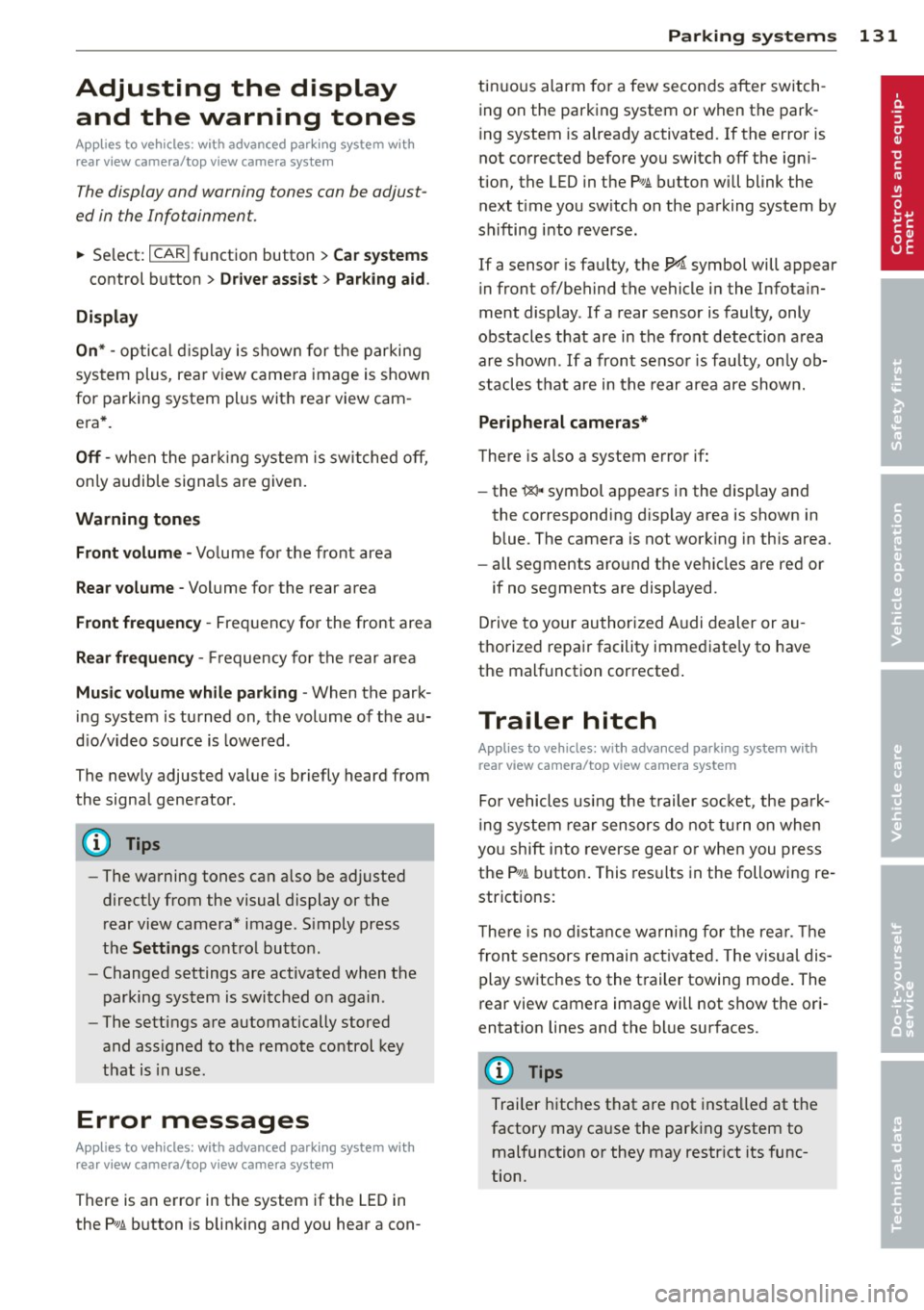
Adjusting the display and the warning tones
App lies to vehicles: with advanced park ing system wit h
rea r view camera/top v iew camera syste m
The display and warning tones can be adjust
ed in the Infotainment.
~ Se lect: ICARI f u nct io n button > Car systems
control button > Driver assist > Parking aid .
Display
On * -
opti cal d isplay is shown for the parking
sys tem plus, rea r view came ra image is shown
for parking system plus with rear view cam
e ra *.
Off -when t he par king system is sw itched off,
on ly audib le sign als are given.
Warning tones
Front volume -
Volume for the fro nt area
Rear volume -Volume for the rear area
Front frequency -Frequency for the front area
Rear frequency -Frequency for the rear area
Music volume while parking -When the park
in g system is turned on, the vol ume of t he au
d io/v ideo source is lower ed.
The new ly adjusted value is briefly heard from
the signa l generator.
@ Tips
- The warning tones ca n also be adjusted
direct ly from the visual display or the
rear view camera* image. S imply press
the
Settings cont ro l but to n.
- Changed settings are activated when the
parking system is switched on aga in.
- The settings are automatically stored
and ass igned to the remote control key
that is in use .
Error messages
Applies to vehicles: with a dvanced park ing system wit h
r ea r view camera/top v iew camera syste m
There is an error in t he system if the LED in
the
?# A button is blinking and you hear a con-
Parking systems 131
tin uous alarm fo r a few seconds after switch
ing on the par king system or when the park
ing system is already activated. If the error is
not corrected before you switc h off the ign i
tion, the LED in the
P,1 1.A button will blink the
next t ime you sw itch on the parking system by
shifting i nto reverse .
If a sensor is fa ulty, the!¾ symbol will appear
in front of/behind the vehicle in the Infota in
ment display . If a rear sensor is faulty, only
obstacles that are in the front detec tion a rea
a re shown . If a front sensor is fau lty, on ly ob
s tacles t hat are in the rear area are shown.
Peripheral cameras*
There is also a system error if:
- the
'(gl ,, symbol appears i n the display and
the corresponding d isp lay area is shown in
blue. The camera is not work ing in this area.
- all segments aro und the vehicles are red or
if no segments are displayed.
D rive to your authorized A udi dealer or au
thorized repair facility immed iate ly to have
the malfunction correcte d.
Trailer hitch
Applies to vehicles: wi th adva nced parking syste m with
rear view ca mera/top view ca mera system
Fo r vehicles using the trailer so cket, the pa rk
i ng sys tem rear sensors do not tu rn on when
you shift i nto reverse gea r or when you press
the
P,#~ button . This res ults in the following re
strictions:
T he re is no dist ance warn ing fo r th e rea r. T he
fron t sensors remain act ivated. The visua l dis
play switches to the t railer towing mode . The
rear view camera image will not show the or i
entat ion lines and the bl ue surfaces.
(D Tips
Trai ler h itches that are not insta lled at the
factory may ca use the park ing system to
malfunction or they may restr ict its func
tion.
Page 134 of 318

132 Homelink®
Homelink®
Universal remote
control
General information
Applies to vehicles: with Homelink® universal remote
control
The Homelink universal remote control can
be programmed with hand-held transmitters
from existing equipment.
Using the Homelink universal remote control
you can operate equipment such as garage doors, property gates and house l ights from
ins ide your vehicle . '
Using the Homelink universal remote control '
you can replace up to three separate hand-
held transmitte rs for equipment on your
property with just one universal remote con
trol. Most of these transmitters a re used to
ope rate ga rage doo rs and property g ates. The
individua l transmitters are programmed at
the front bumper. That is where the control
module is located.
The transmi tters must be p rogrammed first in
orde r to operate systems using the Homelink
universal remote control.
A WARNING
- Never use the Homelink ® transmitter
with any garage door opener that does have not the safety stop and reverse fea
ture as requ ired by federa l safety stand
ards . T his includes any garage door open
er model manufact ured before April 1,
1982.
- A garage door opener which cannot de
tect an object, signaling the door to stop
and reverse does not meet current feder
al safety s tandards . Us ing a ga rage doo r
opener witho ut these fea tures increases
risk of serious injury or death.
- For safety reasons never release the
parking brake or start the engine while
anyone is standing in front of the vehicle .
- A garage door or an estate gate may
sometimes be set in motion when the Homelink
® remote control is being pro
grammed. If the device is repeatedly ac
tivated, th is can overstrain motor and
damage its e lectrica l components - an
overhea ted mo tor is a fire hazard !
- To avo id possib le injuries or property
damage, please always make absolutely
certa in that no persons or ob jects are lo
cated in the rang e of motion of any
eq uipme nt bei ng ope rated.
(0 Tips
- If you would like add itional information
on the Hom e Link ® Unive rsal Transce iver
'
Home link compatib le p rod ucts, or to
pur chase other acce ssories s uch as the
Homel ink® Light ing Package, please
contact Homelin k at 1-800 -355 -3515 o r
on the Internet at www.homelink .com.
- For Declaration of Comp liance to Unite d
States FCC and Ind ustry Canada reg ula
tions ¢
page 299.
'Operation
Applies to vehicles: with Homelink
F ig. 151 Contro l u ni t in the head liner
-"' 8 ± .. .,
Requi rement: The buttons must be program
med
¢ page 133.
'" Press the p rogrammed button¢&_ in Gen
eral information on page 132
to open the
ga rage door. The light @will blink or turn
on.
'" Press the b utton again to close the garage
door ¢
&. in General information on
page 132.
~
Page 135 of 318
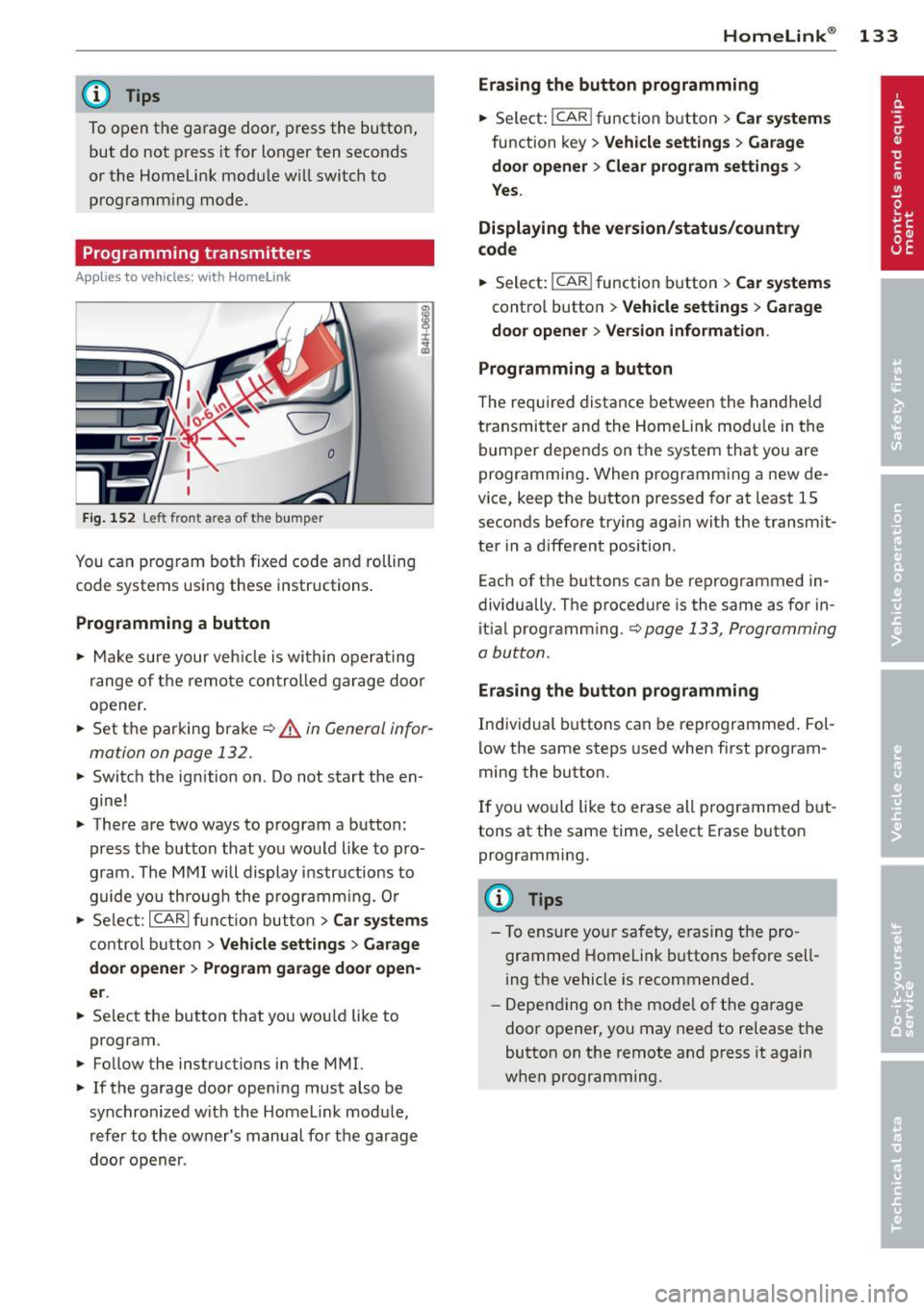
@ Tips
To open the garage door, press the button,
but do not press it for longer ten seconds
or the Homelink modu le w ill switch to
programming mode .
Programming transmitters
Applies to vehicles : wit h Home link
Fig. 152 Left front a rea o f the bum per
You can program both fixed code and rolling
code systems using these instructions .
Programming a button
.,. Make sure your veh icle is within operating
range of the remote control led garage door
opener.
.,. Set the parking brake
¢ A in General infor
mation on page 132.
.,. Switch the ignition on . Do not start the en
gine!
.,. There are two ways to program a button :
press the button that you would like to pro
gram . The MMI will display instructions to
guide you throug h the programm ing. Or
.,. Select :
I CAR I function button > Car systems
control button > Vehicle settings > Garage
door opener> Program garage door open
er .
.,. Se lect the button that you wou ld like to
program.
.,. Follow the instructions in the MMI.
.,. If the garage door opening must also be
synchronized w ith the Homelink module ,
refer to the owner's manual for the garage
doo r opener .
Homelink ® 133
Erasing the button programming
.,. Select: !CAR lfunction button> Car systems
function key> Vehicle settings > Garage
door opener
> Clear program settings >
Yes.
Displaying the version/status/country
code
.,. Select: I CAR ! function button > Car systems
control button > Vehicle settings > Garage
door opener > Version information .
Programming a button
T he requ ired distance between the handheld
transmitter and the Homelink modu le in the
bumper depends on the system that you are
programming . When programming a new de
vice, keep the button pressed for at least 15
seconds before trying again with the transm it
ter in a different position .
Each of th e buttons can be reprogrammed in
dividually . The procedure is the same as for in
itial programm ing .¢
page 133 , Programming
a button .
Erasing the button programming
Individual buttons can be reprogrammed. Fol
low the same steps used when first program
ming the button .
If you would like to erase all prog rammed but
tons at the same time, select Erase button
programming.
@ Tips
- To ensure your safety, eras ing the pro
grammed Homelink buttons before sell
ing the vehicle is recommended.
- Depending on the mode l of the garage
door opener, you may need to release the
button on the remote and press it again
when programming .
Page 136 of 318
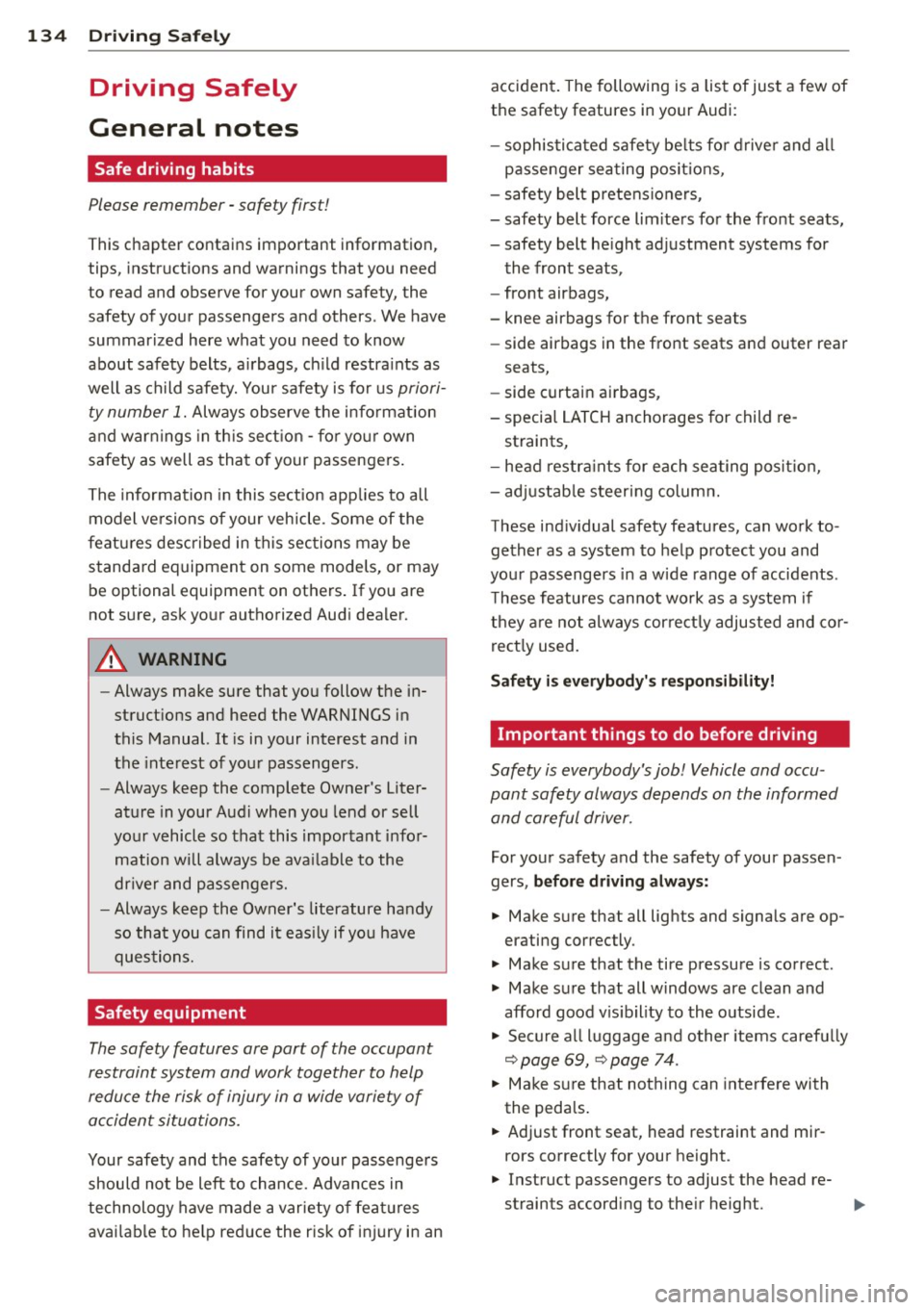
134 Driving Safel y
Driving Safely
General notes
Safe driving habits
Please remember -safety first!
This chapter contains important information,
tips, instructions and warnings that you need
to read and observe for your own safety, the
safety of your passengers and others . We have
summarized here what you need to know
about safety belts, a irbags, ch ild restra ints as
well as child safety. Your safety is for us
priori
ty number 1.
Always observe the info rmat ion
and warn ings in th is sect ion -fo r yo ur own
safety as well as that of your passengers .
The information in this se ction app lies to all
model ve rsions of your veh icle . Some of the
feat ures desc ribed in this sec tions may be
standard equipment on some models, or may
be optional equipment on others . If you are
not sure, ask your authorized Aud i dealer.
A WARNING
- Always make sure that you follow the in
struct ions and heed the WARNINGS in
this Manual. It is in your interest and in
the inte rest of you r passengers.
- Always keep the complete Owner's Liter
ature in your Audi when you lend or sell
yo ur vehicle so that this important info r
mation will always be ava ilable to the
dr iver and passengers.
- Always keep the Owner's literature handy
so that you can find i t eas ily if you have
ques tions.
Safety equipment
The safety features are part of the occupant
restraint system and work together to help
redu ce the risk of injury in a wide variety of
accident situations.
Your safety and the safety of your passenge rs
should not be left to chance. Advances in
technology have made a varie ty o f fea tures
avai la bl e to he lp re duce the risk of inj ury in an accident
. The following is a list of just a few of
the safety features in your Audi:
- sophis tic ated s afety be lts for d rive r and a ll
passenger sea ting pos it ions,
- s afety belt prete nsio ners ,
- safety belt force lim ite rs fo r the front seats,
- safety belt he ight ad justment systems for
the front seats ,
- front airbags,
- knee airbags for the front seats
- side airbags in the front seats a nd outer rear
seats,
- side c urtai n airbags ,
- specia l LATCH anchorages for child re-
straints,
- he ad restr aints for each sea ting pos ition,
- ad justab le s teer ing colum n.
These ind iv idual safety features, can work to
ge ther as a system to help protect you and
you r passengers in a wide range of accidents .
T hese features canno t wo rk as a system if
they are not always cor re ct ly adjusted and co r
rect ly used.
Safety is ev erybody' s responsibility!
Important things to do before driving
Safety is everybody 's job! Vehicle and occu
pant safety always depends on the informed and careful driver .
For your safety and the safety of your passen
gers,
befor e driv ing always:
.. Make s ure that all lig hts and signa ls are op
erating correctly.
.. Make sure that the tire pressure is correct .
.. Mak e sur e that all windows are clean and
afford good v is ibility to the outside .
.. Se cu re a ll luggage a nd o ther items carefu lly
<:!) page 69, ¢page 74.
.. Ma ke s ure that noth ing can interfere wi th
the peda ls .
.. Adjust front seat, head restraint and mir
rors correctly for your height.
.. Instruct passengers to adjust the head re-
straints according to the ir height . .,..
Page 137 of 318
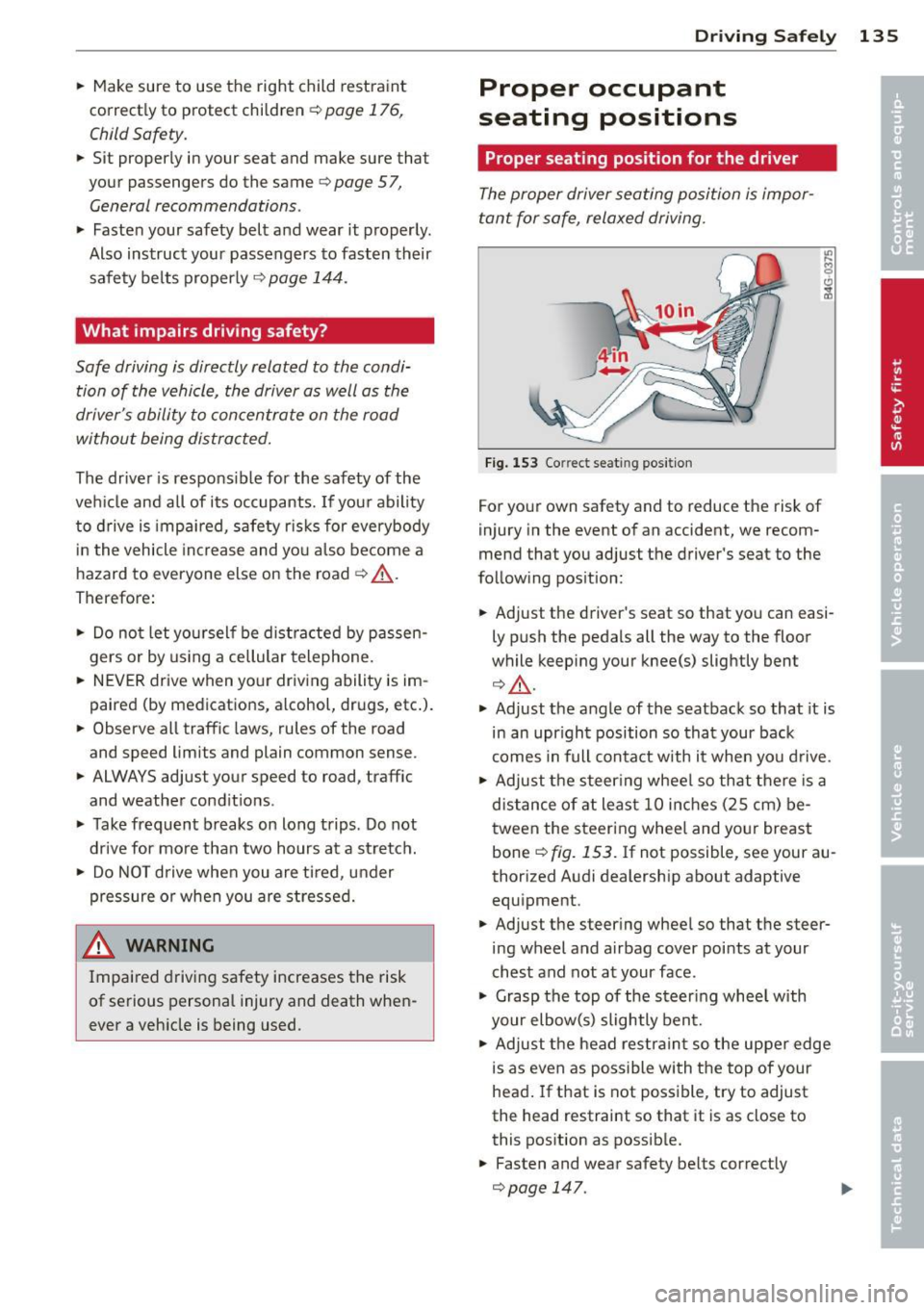
.. Make sure to use the right child restraint
correct ly to protect children
Q page 176,
Child Safety.
.. Sit properly in your seat and make sure that
your passengers do the same
¢ page S7,
General recommendations .
.. Faste n your safety belt and wear it properly.
Also instruct your passengers to fasten their
safety belts properly ¢
page 144 .
What impairs driving safety?
Safe driving is directly related to the condi
tion of the vehicle, the driver as well as the
driver 's ability to concentrate on the road
without being distracted.
The driver is respons ible for the safety of the
veh icle and all of its occupants.
If your ability
to drive is impai red, safety r isks for everybody
in the vehicle increase and you also become a
hazard to everyone else on the road ¢ _&. .
Therefore:
.. Do not let yourself be dist racted by passen
gers or by using a cellular telephone.
.. NEVER drive when your driving ability is im
paired (by medications, alcohol, drugs, etc.).
.. Observe all traffic laws, rules of the road
and speed limits and plain common sense .
.. ALWAYS adjust your speed to road, traffic
and weather conditions .
.,. Take frequent breaks on long trips . Do not
drive for more than two hours at a stretch.
.. Do NOT drive when you are tired, under
pressure or when you are stressed.
A WARNING
Impaired driving safety increases the risk
of serious personal injury and death when
ever a vehicle is being used.
Driving Safely 135
Proper occupant
seating positions
Proper seating position for the driver
The proper driver seating position is impor
tant for safe, relaxed driving .
Fig. 153 Correct seat ing pos it ion
For your own safety and to reduce the risk of
injury in the event of an accident, we recom
mend that you adjust the driver's seat to the
follow ing pos ition:
.. Adjust the driver's seat so that you can easi
ly push the pedals all the way to the floor
wh ile keeping your knee(s) slightly bent
¢ _&. .
.. Adjust the angle of the seatback so that it is
in an upr ight position so that your back
comes in full contact w ith it when you drive.
.. Adjust the steering wheel so that there is a
distance of at least 10 inches (25 cm) be
tween the steering wheel and yo ur breast
bone
Q fig. 153. If not possible, see your au
thorized Audi dealership about adaptive
equipment .
.. Adjust the steer ing wheel so that the steer
ing wheel and airbag cover points at your
chest and not at your face.
.,. Grasp the top of the steering whee l with
your elbow(s) slightly bent.
.. Adjust the head restraint so the upper edge
is as even as possible with the top of your
head. If that is not poss ible, try to adjust
the head restraint so that it is as close to
this position as possible .
.. Fasten and wear safety belts correctly
¢page 147.
Page 138 of 318
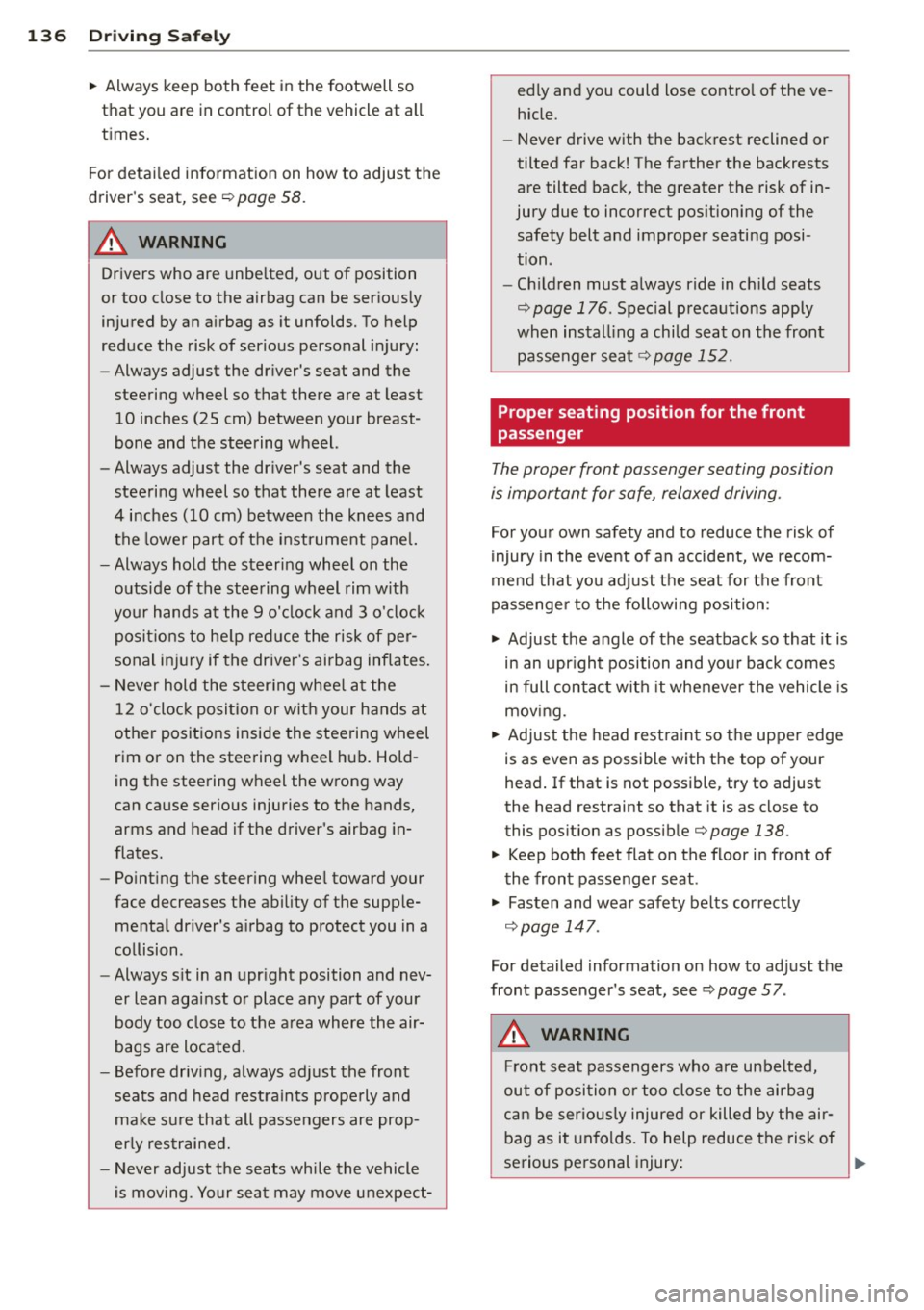
136 Driving Safely
• Always keep both feet in the footwell so
that you are in control of the vehicle at all
times.
For detailed information on how to adjust the
driver's seat, see
¢ page 58.
A WARNING
Drivers who are unbelted, out of position
or too close to the airbag can be seriously
injured by an airbag as it unfolds. To help
reduce the risk of serious personal injury:
- Always adjust the driver's seat and the
steering wheel so that there are at least
10 inches (25 cm) between your breast
bone and the steering wheel.
- Always adjust the driver's seat and the
steering wheel so that there are at least
4 inches (10 cm) between the knees and
the lower part of the instrument panel.
- Always hold the steering wheel on the
outside of the steering wheel rim with
your hands at the 9 o'clock and 3 o'clock positions to help reduce the risk of per
sonal injury if the driver's airbag inflates.
- Never hold the steering wheel at the
12 o'clock position or with your hands at
other positions inside the steering wheel
rim or on the steering wheel hub. Hold
ing the steering wheel the wrong way
can cause serious injuries to the hands,
arms and head if the driver's airbag in
flates.
- Pointing the steering wheel toward your
face decreases the ability of the supple
mental driver's airbag to protect you in a
collision.
- Always sit in an upright position and nev
er lean against or place any part of your
body too close to the area where the air
bags are located.
- Before driving, always adjust the front
seats and head restraints properly and
make sure that all passengers are prop
erly restrained.
- Never adjust the seats while the vehicle
is moving. Your seat may move unexpect- edly and you could lose control of the ve
hicle .
- Never drive with the backrest reclined or
tilted far back! The farther the backrests
are tilted back, the greater the risk of in
jury due to incorrect positioning of the safety belt and improper seating posi
tion .
- Children must always ride in child seats
¢
page 176. Special precautions apply
when installing a child seat on the front passenger seat¢
page 152.
Proper seating position for the front
passenger
The proper front passenger seating position
is important for safe, relaxed driving .
For your own safety and to reduce the risk of
injury in the event of an accident, we recom
mend that you adjust the seat for the front
passenger to the following position :
• Adjust the angle of the seatback so that it is
in an upright position and your back comes in full contact with it whenever the vehicle is
moving.
• Adjust the head restraint so the upper edge
is as even as possible with the top of your
head. If that is not possibl e, try to adjust
the head restraint so that it is as close to
this position as possible¢
page 138.
• Keep both feet flat on the floor in front of
the front passenger seat .
• Fasten and wear safety belts correctly
¢page 147.
For detailed information on how to adjust the
front passenger's seat, see ¢
page 5 7.
A WARNING
-
Front seat passengers who are unbelted,
out of position or too close to the airbag
can be seriously injured or killed by the air
bag as it unfolds. To help reduce the risk of
serious personal injury:
Page 139 of 318
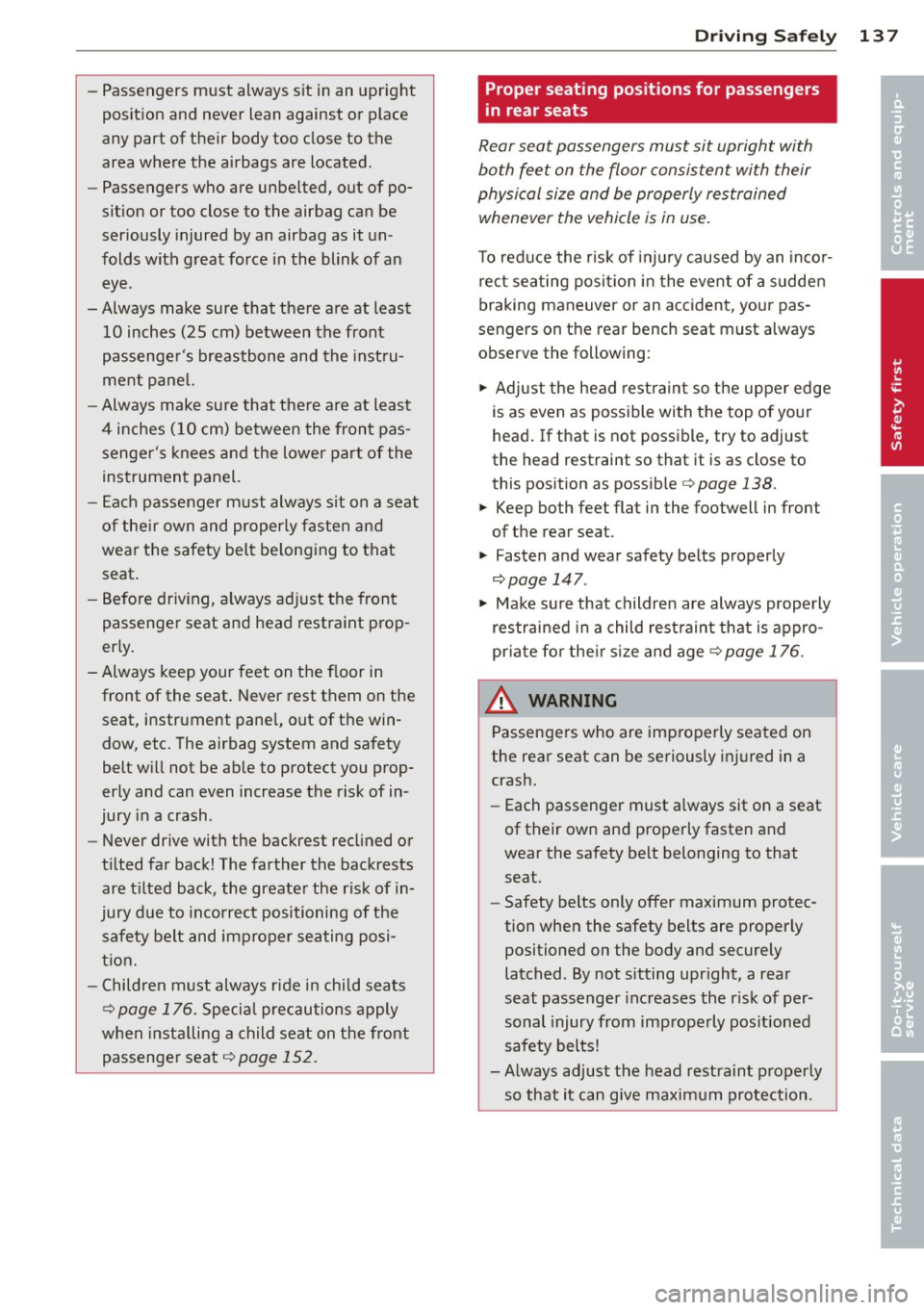
-Passengers must always sit in an upright
position and never lean against or place
any part of their body too close to the
area where the airbags are located.
- Passengers who are unbelted, out of po
sition or too close to the airbag can be
seriously injured by an airbag as it un
folds with great force in the blink of an
eye.
- Always make sure that there are at least
10 inches (25 cm) between the front
passenger's breastbone and the instru
ment panel.
- Always make sure that there are at least
4 inches (10 cm) between the front pas
senger's knees and the lower part of the
instrument panel.
- Each passenger must always sit on a seat
of their own and properly fasten and
wear the safety belt belonging to that
seat.
- Before driving, always adjust the front
passenger seat and head restraint prop
er ly.
- Always keep your feet on the floor in
front of the seat. Never rest them on the
seat, instrument panel, out of the win
dow, etc. The airbag system and safety
belt will not be able to protect you prop
erly and can even increase the risk of in
jury in a crash .
- Never drive with the backrest reclined or
tilted far back! The farther the backrests
are tilted back, the greater the risk of in
jury due to incorrect positioning of the
safety belt and improper seating posi
tion.
- Children must always ride in child seats
¢
page 176. Special precautions apply
when installing a child seat on the front
passenger seat ¢
page 152.
Driving Safely 137
Proper seating positions for passengers
in rear seats
Rear seat passengers must sit upright with
both feet on the floor consistent with their
physical size and be properly restrained
whenever the vehicle is in use.
To reduce the risk of injury caused by an incor
rect seating position in the event of a sudden
braking maneuver or an accident, your pas
sengers on the rear bench seat must always
observe the following:
.,. Adjust the head restraint so the upper edge
is as even as possible with the top of your
head. If that is not possible, try to adjust
the head restraint so that it is as close to
this position as possible¢
page 138 .
.,. Keep both feet flat in the footwell in front
of the rear seat.
.,. Fasten and wear safety belts properly
¢page 147.
.,. Make sure that children are always properly
restrained in a child restraint that is appro
priate for their size and age~
page 176.
,& WARNING
..-
Passengers who are improperly seated on
the rear seat can be seriously injured in a
crash.
- Each passenger must always sit on a seat
of their own and properly fasten and
wear the safety belt belonging to that seat.
- Safety belts only offer maximum protec
tion when the safety belts are properly
positioned on the body and securely
latched . By not sitting upright, a rear
seat passenger increases the risk of per
sonal injury from improperly positioned
safety belts!
- Always adjust the head restraint properly
so that it can give maximum protection.
•
•
Page 140 of 318

138 Driving Safel y
Proper adjustment of head restraints
Correctly adjusted head restraints are an im
portant part of your vehicle's occupant re
straint system and can help to reduce the risk
of injuries in accident situations.
Fig . 15 4 Head restr ain t: vi ewed fro m the front
The head restraints must be correctly adjust
ed to achieve the best protection.
i,.. For adjustable head restraints: adjust the
head restraint so the upper edge is as even
as possible with the top of your head. If that
is not possible, try to adjust the head re
stra int so that it is as close to th is position
as possible.
c:> fig . 154.
Ad justing head restraints c:> page 64 .
Crash - activ e head rest raint s
In the even t of a rear-end collision, it is possi
b le that the crash-act ive head res traint s on
the driver's seat and front passenger 's seat
1>
are triggered . On head restraints that have
been triggered, the padding protrudes for
wards by several centimeters. Drive the vehi cle to your authori zed Aud i dealer without de
lay and have the function of the active head
restra ints restored .
A WARNING
-
Driv ing without head rest raints or w ith
head restra ints that are not properly ad
jus ted in creases the risk of serious o r fatal
neck injury dram atically. To help reduce
the risk of in jury:
1l Vehicle s w ith recl in ing rear seat : Th is f unctio n is not
ava ilab le for t he fro nt pass enge r's seat.
-Always drive with the head restraints in
place and properly adjusted.
- Every person in the vehicle must have a
properly adjusted head restraint.
- Always make sure each person in the ve
hicle properly adj usts their head re
straint. Adjust the head restraint so the
upper edge is as even as possible with
the top of your head. If that is not possi
ble, t ry to adjust the head rest raint so
that it is as close to this posit ion as pos
sible.
- Never attempt to adjust head restraint
while driving. If you have driven off and
m ust adjust the driver headrest for any
reason, first stop the vehicle safely be
fore at tempting to adjust the head re
straint .
- Ch ild ren mus t always be properly re
strained in a child rest rain t that is appro
priate for their age and size
c:> page 176.
Examples of improper seating positions
The occupant restraint system can only re
duce the risk of injury if vehicle occupants are
properly seated.
Improper seating posi tions can cause se rious
i njury or death. Safety belts can on ly wo rk
when they are properly positioned on the body. Improper seating positions reduc e the
effectiven ess of safety belts and wi ll even in
crease the r isk of injury and death by moving
the safety belt to crit ica l areas of t he body.
Improper seating positions a lso increase the
risk of serious in jury and death when an a ir
bag deploys and str ikes an occupant who is
not in the proper seating position. A dr iver is
responsible fo r the safety of all ve hicle occu
pants and espec ially for child ren . The re fore :
i,.. Never allow anyone to assume an incorrect
s eating position when the vehicle is bei ng
used
c:> & - .,.